Netflix Earnings: Disney And Warner Bros. Discovery, Not Fortnite And Sleep, Are The Competition [Parrot Analytics]

While Netflix claims to be competing against the likes of Fortnite and sleep, new Parrot Analytics data reveals the streaming giant’s primary foes in the race for entertainment supremacy are its legacy media opposition, especially Disney and the newly-formed Warner Bros. Discovery.
Netflix’s demand share of streaming originals once again hit new lows in Q1 2022, sitting at 45.2% globally (down from 45.4% in Q4 2021) and 42.4% in the United States (down from 43.6% in Q4 2021). Meanwhile HBO Max, Paramount+, and Disney+ — all SVODs backed by traditional media conglomerates — saw significant gains in the most recent quarter.
Global demand for original content from all of Netflix’s competitors grew 80.8% between Q1 2020 and Q1 2022, more than triple the 25.5% growth for Netflix originals over the same time.
Netflix’s modest global demand growth of late has tracked remarkably closely with its slowing subscriber growth over the same time (up 21.3% worldwide from Q1 2020 to Q4 2021), showcasing the pivotal link between demand for original content and SVOD subscriber growth.
To be clear: Netflix is still the single most dominant player in the streaming industry, especially in demand for original content, a key leading indicator of subscriber growth.
But as several nearly century old firms erode the incumbent’s market share, Netflix is reaching a point where it needs to focus more on subscriber retention, especially in North America, while its legacy media-backed competitors Disney+ and HBO Max continue focusing on subscriber growth in key international territories.
Global Demand for Original Content - Netflix vs. Competitors
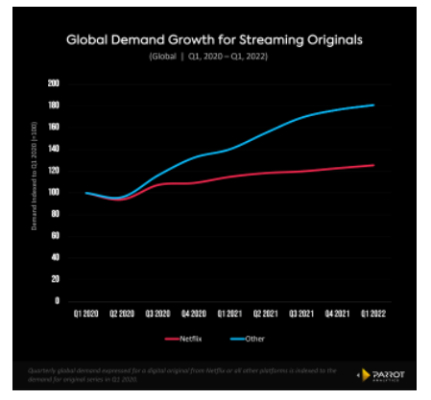
- From Q1 2020 to Q1 2022, the total global demand for Netflix originals increased by 25.5%, while the global demand for originals from all other streamers combined grew 80.8%, more than triple the growth of Netflix.
- Netflix’s slowdown in the growth of demand for its original content is seemingly tied directly to its slowdown in subscriber growth over the last two years.
- From Q1 2020 to Q4 2021, Netflix’s global subscribers grew from roughly 183 million to 222 million, a 21.3% increase in total subscribers. This is remarkably similar to the 22.8% growth in total demand global for Netflix originals from Q1 2020 to Q4 2021, showing the key link between demand for original content and subscriber growth.
- The gap between the growth in demand for Netflix’s competitors’ original content and its own is further evidenced in Netflix’s market share dropping dramatically in the past two years - from 55.7% to 45.2% globally, and from 52.4% to 42.2% in the US between Q1 2020 and Q1 2022.
Global Streaming Originals Demand Share - Q1 2020-Q1 2022
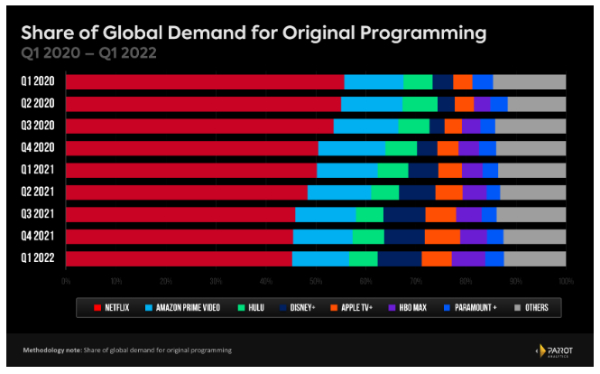
- Netflix’s global demand share for streaming originals sat at 45.2% in Q1 2022 - a record low, but only a slight decrease from Q4 2021 (45.4%).
- However, Netflix is down from 50.2% in Q1 2021 and 55.7% in Q1 2020.
- Disney+ and HBO Max have grown from a combined 6.7% share in Q2 2020 (the first quarter they were both available) to 15.5% in Q1 2022.
- That 8.8 percentage point gain from these Disney and Warner Bros. Discovery owned streamers accounts for the vast majority of the 9.8 percentage point drop that Netflix has taken over the same time period, showing how much these traditional media companies are directly eating into Netflix’s streaming dominance.
Global Streaming Originals Share - Q1 2022
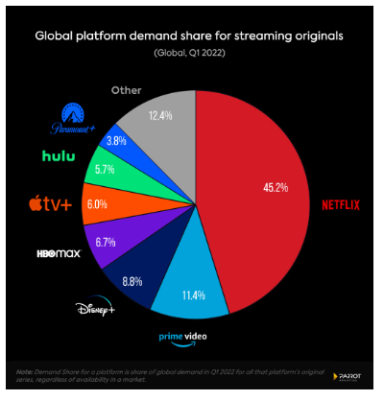
- Netflix remains the dominant service for original content demand with 45.2% global share. Its 45.2% demand share is still larger than that of its six closest competitors combined - Amazon Prime Video, Disney+, HBO Max, Apple TV+, Hulu, and Paramount+ make up a total of 42.4% share globally.
- That said, its competitors are catching up - in Q2 2020 (HBO Max’s launch quarter), Netflix’s six closest competitors combined for 33.4% global demand share, while Netflix stood as 55%.
- HBO Max (6.7%) jumped ahead of Apple TV+ (6%) this quarter, as demand for Ted Lasso faded while Max launched a trio of hit originals targeting significantly different audience sectors with Station Eleven, Peacemaker, and Our Flag Means Death.
United States Streaming Originals Share - Q1 2022
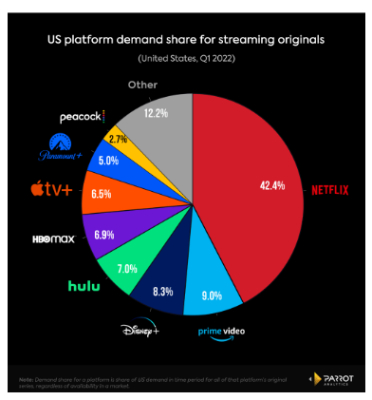
- Netflix had a steeper decline with US consumers, dropping from 43.6% in Q4 2021 to 42.4% in Q1 2022. Netflix’s US share was 48.1% in Q1 2021 and 52.4% in Q1 2020.
- Paramount+ and HBO Max had very strong quarters in the US, and accounted for much of Netflix’s losses in demand share in Q1 2022.
- HBO Max grew from 6.2% to 6.9%, and overtook Apple TV+ in the category with a hits such as Our Flag Means Death, Peacemaker and Station Eleven.
- Paramount+ grew from 4.4% to 5% on the back of Yellowstone spin-off 1883, as well as a new season of Star Trek: Picard.
On-Platform Demand Share - Q1 2022
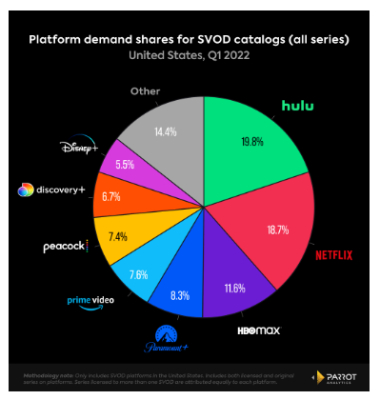
- Netflix is doing well in on-platform demand share, especially considering a plurality of demand for content available on Hulu is non-exclusive licensed content, which has less of an impact on subscriber growth and retention.
- While there is currently a major drop from second to third place in on-platform demand with US audiences, a combination of HBO Max and Discovery+, which Warner Bros. Discovery leadership has repeatedly emphasized is in the works, would make up 18.3% share, just 0.4 percentage points behind Netflix.
- This imminent platform combination represents a strong competitor to Netflix for second place in on-platform demand share, showing how much of a direct threat Warner Bros. Discovery poses to Netflix’s grasp on the entertainment habits of tens of millions of American consumers.
Most In-Demand Streaming Originals - Global, Q1 2022

- As we have established above, demand for original content is a key leading indicator of subscriber growth. Thus it is important to highlight the shows that have drawn the most audience demand.
- Disney+’s The Book of Boba Fett narrowly beat out Netflix’s The Witcher, both of which debuted in late December 2021, as the most globally in-demand series in Q1 2022 (no doubt significantly boosted by appearances from the Mandalorian and Baby Yoda).
- Netflix did account for four of the top ten streaming originals with global audiences for the quarter, tied with Disney+, which also had four.
- While that is a strong showing, it still represents a significant decline from recent times. Just last quarter Netflix had four of the top five global originals, and in Q1 2021 Netflix accounted for seven of the top ten originals worldwide.
- Once again, competition from traditional media - Disney+ in this case - is cutting into Netflix’s core areas of streaming dominance.


 Vegetables New Zealand: Asparagus Season In Full Flight: Get It While You Still Can
Vegetables New Zealand: Asparagus Season In Full Flight: Get It While You Still Can  Bill Bennett: Download Weekly - How would NZ telecoms cope with another cyclone
Bill Bennett: Download Weekly - How would NZ telecoms cope with another cyclone NZ On Air: Firm Audience Favourites Lead NZ On Air Non-Fiction Funding
NZ On Air: Firm Audience Favourites Lead NZ On Air Non-Fiction Funding Insurance and Financial Services Ombudsman: Woman Gets $40k More After Disputing Insurer’s Decision
Insurance and Financial Services Ombudsman: Woman Gets $40k More After Disputing Insurer’s Decision BNZ: A Quarter Of Older NZers Fear Going Online Due To Scam Concerns
BNZ: A Quarter Of Older NZers Fear Going Online Due To Scam Concerns University of Auckland: Scientists Develop Tool To Monitor Coastal Erosion In Fine Detail
University of Auckland: Scientists Develop Tool To Monitor Coastal Erosion In Fine Detail



